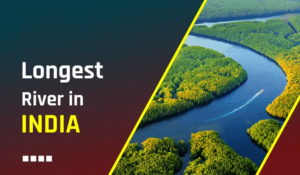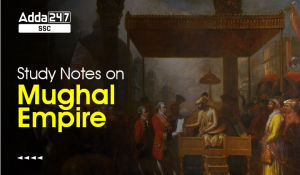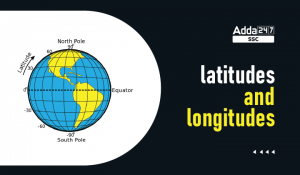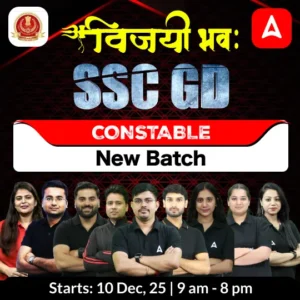The President of India holds the position of the country’s first citizen and nominal head. Since the adoption of the Indian Constitution in 1949, the nation has seen a total of 15 Presidents. The current and 15th President of India is Droupadi Murmu, who took the oath of office on July 25, 2022. The oath was administered by the then Chief Justice of India, N. V. Ramana. This list of the Presidents of India since 1950 will serve as a valuable resource for candidates preparing for competitive examinations.
President of India
The President of India serves as the nominal head of the country and is also the Commander-in-Chief of the Indian Armed Forces. Droupadi Murmu is the 15th President, succeeding former President Ram Nath Kovind. She made history as only the second woman to hold this position, following Pratibha Patil, who served as the 12th President from 2007 to 2012.
Indian President
India gained independence from British rule in 1947, ending over 150 years of colonial domination. On January 24, 1950, Dr. Rajendra Prasad was unanimously elected as the first President of the Republic of India by the Constituent Assembly. Since then, each President has been elected by an electoral college, which includes elected members from the Lok Sabha, Rajya Sabha, State Legislative Assemblies, and the Legislative Assemblies of the Union Territories of Delhi and Puducherry.
The position of President of India is prestigious, yet the balance of power in the Indian Parliament is maintained by designating the President as the nominal head and the Prime Minister as the executive head. The Prime Minister, along with the Cabinet Ministers, aids and advises the President in carrying out daily executive functions.
First President of India
Dr. Rajendra Prasad, the first President of independent India, was born on December 3, 1884, in Saran District, Bihar. He belonged to the Kayastha, or scribe, caste and was a devout Hindu. Prasad received his early education in Bihar and later attended Presidency College in Calcutta. During his presidency, from 1950 to 1962, Dr. Prasad traveled extensively across India and several countries in Asia. In his speeches, he emphasized national and communal unity, the importance of a national language, food scarcity, ways to increase food production, and the achievements of Indian culture. The close cooperation between President Prasad and Prime Minister Jawaharlal Nehru helped mitigate the challenges of the post-independence years. Dr. Rajendra Prasad passed away on February 28, 1963, in Patna.
List of Presidents of India
Dr. Rajendra Prasad (Jan 26, 1950 – May 13, 1962)
Dr. Rajendra Prasad was the first President of independent India, serving two consecutive terms. He also played a key role as the President of the Constituent Assembly and was a prominent leader in the Indian Independence Movement. In recognition of his contributions, he was awarded the Bharat Ratna, the highest civilian award in India, in 1962.
Dr. Sarvepalli Radhakrishnan (May 13, 1962 – May 13, 1967)
Dr. S. Radhakrishnan was an esteemed Indian philosopher and educator, known for his teaching in India and at Oxford University. His birthday is celebrated as National Teacher’s Day in India. In recognition of his contributions to education and philosophy, he was awarded the Bharat Ratna in 1954.
Dr. Zakir Hussain (May 13, 1967 – May 03, 1969)
Dr. Zakir Husain was a renowned Indian economist and politician who served as the 3rd President of India. Before his presidency, he was the Governor of Bihar from 1957 to 1962 and the Vice President of India from 1962 to 1967. In recognition of his contributions, he was awarded the Padma Vibhushan in 1954 and the Bharat Ratna in 1963 for his exceptional service to the nation.
V.V. Giri (Acting) (May 03, 1969 – July 20, 1969); Full Term (August 24, 1969 – August 24, 1974)
After the demise of Dr. Zakir Husain, Varahagiri Venkatagiri, commonly known as V.V. Giri, became the acting President of India. He is notable for being the only person elected as an independent candidate for the presidency. However, he resigned after two months, as he wanted to run for the position as an elected candidate. He later successfully served his full term as President from 1969 to 1974.
Justice Mohammad Hidayatullah (July 20, 1969 – August 24, 1969) (Acting)
He was the 11th Chief Justice of India, serving from February 25, 1968, to December 16, 1970, and later became the sixth Vice President of India, holding office from August 31, 1979, to August 30, 1984. Additionally, he served as the Acting President of India from July 20, 1969, to August 24, 1969, following the resignation of V.V. Giri.
Fakhruddin Ali Ahmed (August 24, 1974 – February 11, 1977)
He served as the President of India during the period of the Emergency. He was the second Muslim to be elected as President and also the second to die in office. In his honor, a medical college named Fakhruddin Ali Ahmed Medical College has been established in Barpeta, Assam.
B.D. Jatti (Acting) (February 11, 1977 – July 25, 1977)
After the death of Fakhruddin Ali Ahmed, Basappa Danappa Jatti served as the Acting President of India from February 11 to July 25, 1977. He also held the position of Vice President of India from 1974 to 1979.
Neelam Sanjiva Reddy (July 25, 1977 – July 25, 1982)
He was the first Chief Minister of Andhra Pradesh and also the first to be elected unopposed. Additionally, he was the youngest person to occupy Rashtrapati Bhavan. In 1977, he took a 70 percent cut in his salary as a gesture to support the poor economic conditions at the time.
Giani Zail Singh (1982 – 1987)
The only Sikh President of India to date, he also served as the Chief Minister of Punjab. He came under scrutiny during Operation Blue Star, when then Prime Minister Indira Gandhi ordered security forces to confront Jarnail Singh Bhindranwale and his armed followers in the Golden Temple, Amritsar.
R. Venkataraman July 25, 1987 – July 25, 1992
As President of India, Venkataraman had the unique distinction of working with four different Prime Ministers. Before he was elected President, he served as the Governor of several institutions, including the International Monetary Fund, the International Bank for Reconstruction and Development, and the Asian Development Bank.
Dr. Shankar Dayal Sharma July (25, 1992 – July 25, 1997)
He previously served as the eighth Vice President of India and as the Chief Minister of Bhopal state. As a member of Congress, he participated in the movement against the Nawab of Bengal, who sought to retain control over the princely state.
K.R. Narayanan (July 25, 1997 – July 25, 2002)
He was the first Dalit-origin President of India. K.R. Narayanan, who had previously served as a diplomat, held positions as India’s ambassador to both China and the United States. He notably dissolved the Lok Sabha twice, first when he refused to dismiss the Kalyan Singh government in Uttar Pradesh in 1997 and then the Rabri Devi government in Bihar in 1998.
Dr. A.P.J. Abdul Kalam (July 25, 2002 – July 25, 2007)
Popularly known as the “Missile Man of India,” Dr. A.P.J. Abdul Kalam was the first scientist to become President in 2002. He was affectionately called the People’s President and was awarded the Bharat Ratna in 1997. During his tenure, he played a key role in the successful launch of the Rohini-1 satellite and the Agni and Prithvi missiles.
Pratibha Patil (July 25, 2007 – July 25, 2012)
She was the first woman to become the President of India. During her tenure, she commuted the death sentences in 19 cases and rejected petitions in three others. From 1962 to 1985, she served five terms as a member of the Maharashtra Legislative Assembly and was elected to the Lok Sabha from Amravati in 1991.
Pranab Mukherjee (July 25, 2012 – July 25, 2017)
Mukherjee is the only President of India who has served in all the major portfolios at the Centre—Foreign Affairs, Defence, Commerce, and Finance—during his political career. In 1984, he was voted the Best Finance Minister in the World by Euromoney magazine. Additionally, he received the Best Parliamentary Award in 1997 and was honored with the Padma Vibhushan, India’s second-highest civilian award, in 2008.
Ram Nath Kovind (July 25, 2017 – 25th July 2022)
He is only the second Dalit leader after R.K. Narayanan to occupy India’s highest ceremonial post since Independence. He previously served as the Governor of Bihar, and his approach to political issues earned him praise across the political spectrum. During his tenure as Governor, he notably established a judicial commission to investigate corruption in universities.
Droupadi Murmu ( Elected as the 15th President, Oath on 25th July 2022)
She was elected as the 15th President of India, surpassing Yashwant Sinha in Parliament on July 21, 2022. She made history as India’s first Tribal woman President. Her career began with her election as a councilor, eventually becoming the Vice-Chairperson of Rairangpur Nagar Panchayat. She also served as the Governor of Jharkhand from 2015 to 2021.
List of All Prime Ministers of India – Click to Check
Eligibility Criteria for President of India
Article 58 of the Indian Constitution says that the candidate for President of India must:
- President must be a citizen of India.
- The president must have completed the age of thirty-five years.
- The presidential candidate should be qualified for elections as a member of the Lok Sabha.
- The president must not hold any office of profit under the Union or any State government, or any local or other authority.
Election of President of India
The election for the President of India is conducted using a system of proportional representation through the single transferable vote, with voting done by secret ballot. To nominate a candidate for the presidency, at least 50 electors must support the nomination as proposers and an additional 50 electors must act as seconders.
The President of India is elected not directly by the people but by members of the electoral college consisting of:
- The elected members of both Houses of Parliament;
- The elected members of the legislative assemblies of the states; and
- The elected members of the legislative assemblies of the Union Territories of Delhi and Puducherry.
- Every candidate has to make a security deposit of Rs 15,000 in the Reserve Bank of India.
- The Supreme court inquires about all the disputes regarding the President’s Election.
- Takes both in presence of the Chief Justice of India or in his absence, the senior-most Judge of the Supreme Court
President of India Term of Office
Article 56 of the Indian Constitution says that:
- The President of India shall hold office for a term of 5 years.
- There is no upper limit on the number of times a person can become President of India
- The President of India can give their resignation to the Vice-President before the full term.
- The President of India is elected for five years but he/she is eligible for immediate re-election and can serve any number of terms.
President Salary and Residence
The salary and allowances of the President of India are determined by the Parliament of India. Currently, the President receives a monthly salary of ₹5,00,000. The official residence of the President is Rashtrapati Bhavan, located in New Delhi.
Impeachment of President
Impeachment is the process of removing the President of India from office before the end of their term. It can occur if the President violates the Constitution of India, and the proceedings can be initiated in either house of Parliament. A two-thirds majority is required to pass the resolution in the House. Once passed, a notice signed by a quarter of the members, detailing the charges, is sent to the President. After 14 days, the other House considers the charges, during which the President has the opportunity to defend themselves. If the charges are approved by the second House as well, the President is impeached and must leave office.
Powers of President
- The President of India appoints various key officials, including the Prime Minister, Ministers, the Chief Justice, and judges of the Supreme Court and High Courts, as well as the Chairman and members of the UPSC. Additionally, the President appoints the Comptroller and Auditor General, the Attorney General, the Chief Election Commissioner and other members of the Election Commission of India, Governors, members of the Finance Commission, and Ambassadors.
- President holds the power to summon & prorogue the sessions of the 2 houses & can even dissolve Lok Sabha.
- President appoints the finance commission (after every 5 years) that recommends the distribution of taxes between Union & State governments.
The President can promulgate 3 types of Emergencies:-
- National Emergency (Article 352)
- State Emergency (President’s Rule) (Article 356)
- Financial Emergency (Article 360)
- President appoints Chief of Army, Navy, and Air Force.
- Declares wars & concludes peace subject to the approval of the Parliament
- No money bill or demand for grants can be introduced or moved in Parliament unless it has been recommended by the President.
- The president has the power to grant pardon, reprieve or remit punishment, or commute death sentences.
Important Facts
- Till now, seven Presidents of India have been members of a political party before being elected as President.
- Six of them were active members of the Indian National Congress.
- The First President of India, Dr. Rajendra Prasad is the only person to have held office for two terms.
- Ram Nath Kovind was the Governor of Bihar before he became the President of India.
- Prathiba Devisingh Patil was the first female President of India.



 Top 10 Longest Rivers in India, Largest ...
Top 10 Longest Rivers in India, Largest ...
 Mughal Empire Notes For RRB NTPC Exam 20...
Mughal Empire Notes For RRB NTPC Exam 20...
 Longitude and Latitude of India - Defini...
Longitude and Latitude of India - Defini...









